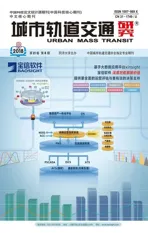展望上海地铁列车的后5 000辆时代
2018-08-20孙章
孙 章
(同济大学《城市轨道交通研究》主编,教授)

7月19日,一列上海地铁2号线最新型号列车闪亮登场。它不仅是上海第840列地铁列车,而且标志着上海地铁车辆进入5 000辆时代。上海地铁的车辆保有量位列全国地铁城市前列,目前每天投入运营的地铁列车有630多列,车辆数约有3 800多。
上海地铁自1993年5月28日开通运营至今,已有25年。1995年运行在1号线上的首批16列车(系6节编组,共计96辆)都从德国进口,建设经费、购车经费都来自德国贷款;2005年,由外方主导设计,上海地铁车辆开始进入国产化时代;2007年,上海地铁车辆保有量突破1 000辆;2008年,实现自主设计,国产化水平进一步提高,2009年底车辆保有量达到2 000辆。随着2010年上海世博会的召开,上海提出了“绿色地铁”概念,越来越多的节能降噪技术得到运用。这一阶段的车辆无论设计还是制造都实现了自主化,平均国产化率已超过75%;其中电气传动系统的国产化率超过了50%。2012年夏,车辆保有量突破3 000辆;2016年底,第4 000辆车落户上海;此后只经过一年半时间,上海地铁就迎来了第5 000辆车。
25年来,上海地铁列车不仅在数量上持续增加,而且在质量上不断提升:从最初的依赖全进口到如今的全面国产化;从最初的直流传动列车,过渡到第二代交流传动列车;再从节能环保列车,进化到智能列车(通过传感器和车地无线传输模块可在线监测列车运营状态,从而提升控制和运维平台对列车运营的实时维护保障能力)。上海地铁列车目前正朝着标准化和智能化的目标继续前进。上海地铁列车的全面进步,从一个侧面充分反映了国家改革开放40年所带来的巨大变化。
巴黎的轨道交通已基本实现了车辆、信号、线路的互联互通,列车可以跨线运行。为了推进我国城市轨道交通的高质量发展,提高运营效率,实现资源共享,有关的互联互通国家示范工程正在实施:中国城市轨道交通协会提出了中国城市轨道交通信号系统CBTC(基于通信的列车控制)互联互通规范,并正在建设重庆轨道交通CBTC互联互通示范工程;另一个示范工程是北京燕房线的全自动运行系统。由于通信平台是互联互通的基础,如何联手推进5G等前沿信息技术的应用,也应成为城市轨道交通的发展方向之一。
目前,我国的城市轨道交通建设,正在从超强度建设转变为高质量发展;其规划正在从注重城市内部发展转变为同时注重城市群内的一体化规划。与此相关的是,城市轨道交通的制式也正在从地铁单一制式向多制式发展转变,在“十三五”期间特别要补上市域(郊)铁路、城际铁路这两块“短板”。由此展望,上海未来的轨道交通列车,必将在一体化、标准化、智能化的轨道上继续奋勇前进。
Commentary
Look Ahead to the Post 5 000 Vehicles′ Era of Shanghai Metro Trains
SUNZhang
(Editor-in-Chief ofUrbanMassTransitof Tongji University, Professor)
On July 19, 2018, the latest model train of Shanghai Metro Line 2 made its debut. It is not only the 840th column of metro train in Shanghai, but also is a sign of Shanghai metro vehicles′ entering 5 000 vehicles′ era. Shanghai metro vehicles′ holdings are ranked in the forefront of the national metro cities. Shanghai metro trains in the current daily operations have more than 630 columns, and the number of their vehicles is more than 3 800.
It is 25 years up to now since Shanghai metro was opened on May 28, 1993. In 1995, the first 16 trains running on Line 1 (Each train was 6 vehicles′ train-formation, and there was a total of 96 vehicles.) were all imported from Germany, the construction funds and train purchase funds were both from Germany loans. In 2005, by the foreign-led designs, Shanghai metro began to enter the localization era. In 2007, Shanghai metro train vehicles′ holdings exceeded 1 000. In 2008, the independent designs of metro trains were realized, and the localization level was further improved. By the end of 2009, Shanghai metro train vehicles′ holdings had reached 2 000. With the 2010 Shanghai World Expo held, Shanghai put forward the concept of "Green Metro". More and more energy-saving and noise-reducing technologies were used. At this phase, both the metro trains′ designs and their manufactures have achieved autonomy. The average localization rate of metro trains exceeded 75%. Among which, the localization rate of the electric drive system exceeded 50%. In the summer of 2012, the metro train vehicles′ holdings exceeded 3 000. At the end of 2016, the 4 000 th vehicle was settled in Shanghai. Hereafter, only after one year and a half, Shanghai metro ushered in the 5 000 th vehicle.
For the last 25 years, the Shanghai metro trains not only have continued to increase in number, but also have continued to improve in quality, from initial dependence on all importation to today′s overall localization, from the initial DC drive trains to the second-generation′s AC drive trains and evolving to the intelligent trains from the energy-saving and environmental-friendly trains (Through the sensor and the train-ground wireless transmission module, the train operation status could be on-line monitored. Thereby, the control and operation and maintenance platform′s real-time maintenance and guarantee capability for trains would be promoted.). At present, Shanghai metro trains are moving on towards the goal of standardization and intellectualization. The overall progress of Shanghai metro trains reflects the great changes brought about by the country′s 40-year reform and opening-up from one side.
The rail traffic in Paris has basically realized the interconnection of vehicles, signals and lines. Their trains could run across lines. In order to promote the high quality development of our country′s urban rail transit, improve its operational efficiency and realize resource sharing, the relevant national demonstration projects of interconnection are being implemented. China Association of Metros has put forward the CBTC (Communication Based Train Control) interconnection specification of Chinese urban rail transit signal system and the demonstration project of Chongqing Rail Transit CBTC Interconnection is being constructed. Another demonstration project is the fully-automatic operation system of Beijing Metro Yan-Fang Line. Because communication platforms are the basis of interconnection, how to jointly push forward the application of 5G and other frontier information technology should be one of the development directions of urban rail transit.
At present, the urban rail transit constructions of our country are changing from super-strength constructions to high quality development. The rail transit planning is changing from paying attention to the inner development of the city to simultaneously paying attention to the integration planning inner the urban agglomeration. Being related to this is that urban rail transit systems are also changing from the metro′s single mode to the multi-mode development. During "the 13th Five-Year Plan" period, these two "short plates" of city railways and intercity railways should specially be mended. Therefore, looking ahead from this, Shanghai′s future rail transit trains will continue to advance courageously on the track of integration, standardization and intellectualization.
(Translated by SUN Zheng)
